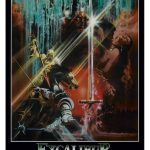Verónica (2017)

In the realm of modern horror, Verónica (2017) stands out as a chilling masterpiece that has captivated audiences with its gripping storyline, terrifying visuals, and unsettling realism. Directed by Paco Plaza, one of the minds behind the critically acclaimed [REC] series, Verónica brings a fresh and disturbing twist to supernatural horror. Loosely based on true events that took place in Madrid in the early 1990s, this film taps into primal fears, blending occult practices with the vulnerability of adolescence.
Plot Overview
The film follows Verónica, a 15-year-old girl living in Madrid, who finds herself drawn into the world of the paranormal after a failed séance with her friends. The séance, which takes place during a solar eclipse at school, was meant to contact Verónica’s deceased father. However, things quickly spiral out of control, and something far more malevolent is summoned. Verónica becomes haunted by terrifying supernatural forces that threaten not only her but also her younger siblings.
As the film progresses, the line between reality and the supernatural begins to blur, pulling the audience deeper into Verónica’s nightmarish descent. The tension builds steadily, supported by atmospheric cinematography and haunting sound design, as the malevolent presence tightens its grip on her life.
Horror Rooted in Reality
One of the aspects that make Verónica so effective is its connection to real events. The movie is inspired by the notorious Vallecas case, where a young girl died under mysterious circumstances following the use of a Ouija board. The case baffled police and paranormal investigators, making it one of Spain’s most infamous and unsolved supernatural occurrences. While the film takes creative liberties, it adds an eerie layer of authenticity to the horror, making it all the more unsettling.

andra Escacena, in her debut role as Verónica, delivers a heart-wrenching and believable performance, making the audience truly feel for her character as she struggles against forces she cannot understand. Her portrayal of fear and desperation is raw and palpable, drawing viewers into her terrifying experiences. Paco Plaza’s direction enhances the terror by using simple but effective techniques—dark shadows, eerie silences, and sudden, spine-tingling apparitions that strike at the right moment, keeping the audience on edge throughout.
Atmosphere and Cinematography
What sets Verónica apart from other horror films is its use of atmosphere. The claustrophobic setting of the family’s apartment, dimly lit and filled with religious icons, adds to the sense of impending doom. The film’s color palette and camera work evoke a sense of dread, while the sound design—a mix of unsettling silence and jarring noises—heightens the tension. Plaza skillfully uses visual storytelling to convey the psychological torment Verónica endures as she becomes increasingly isolated from reality.
Why You Should Watch It
If you’re a fan of supernatural horror that digs deep into psychological and emotional terror, Verónica is a must-watch. It combines the best elements of traditional ghost stories with modern filmmaking techniques, offering an experience that is both disturbing and thought-provoking. The slow-burn pacing allows the tension to build naturally, culminating in a terrifying climax that will stay with you long after the credits roll.
Despite being a Spanish-language film, Verónica transcends language barriers with its universal themes of fear, loss, and the supernatural. It’s a haunting tale that lingers in the back of your mind, making you question the unseen forces that might be lurking in the shadows.
Suggested videos for you:











